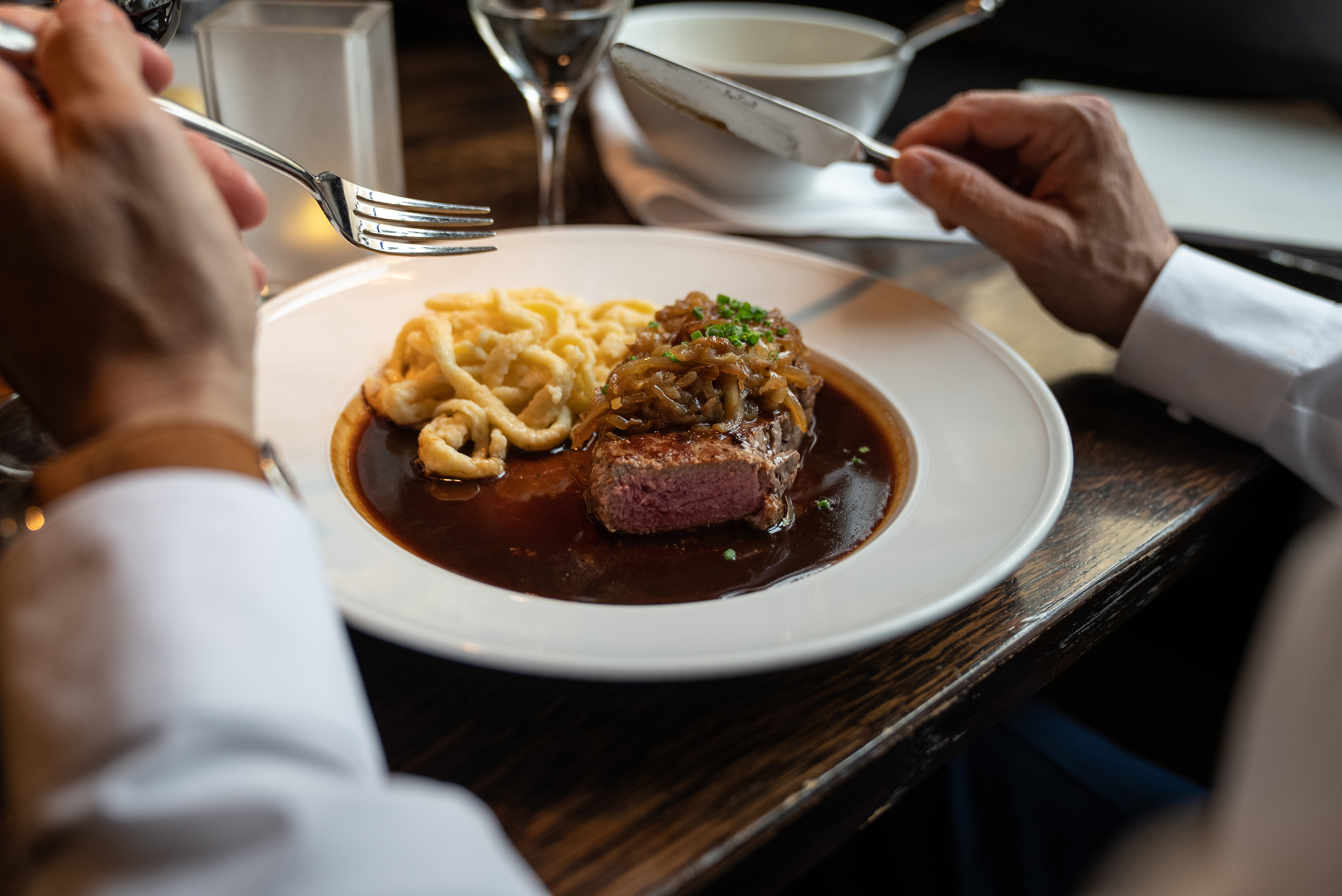Stuttgart for Epicures
Baden-Württemberg's state capital has a wide range of culinary highlights on offer: from gourmet cuisine and down-to-earth favourites to exquisite wines and refreshing beers, an informative walk round the Museum of Viniculture or fascinating guided brewery tours – there's guaranteed to be something to suit every taste.
There are no fewer than 22 starred restaurants in the Stuttgart Region, eight of them in the state capital itself. In addition to regional specialities, there's also Asian or French cuisine on offer. You'll find everything from traditional and classic dishes to haute cuisine and creative, innovative gastronomy. At the Wielandshöhe the emphasis is on organic ingredients and species-appropriate livestock husbandry and the Speisemeisterei, that received its second star in 2022, enhances the menu with theme evenings and art exhibitions to match the food.
Not starred, but no less excellent is the traditional Swabian fare. Besides the famous "Linsen mit Spätzle und Saitenwürschtle" (lentils with noodles and sausages), typical local specialities include "Herrgottsb’scheißerle" (alias "Maultaschen" = filled pasta), "Gaisburger Marsch" (a tasty hotpot with potatoes, noodles and meat) or "Ofenschlupfer" (bread pudding) with vanilla custard. All of these delicacies are to be found either in Swabian restaurants and wine bars, or in Besenwirtschaften (the temporary "broom taverns" operated by local wine growers). They open at various times throughout the year in different parts of town and are famous not just for the broom over the entrance, but for the wines served there, which come from the vintners' own vineyards.
It's hard to decide which wine to choose, especially at the Stuttgart Wine Festival in late summer. With over 500 different Württemberg wines Bacchus himself would be in seventh heaven. Locals like to order a traditional "Viertele" (1/4 litre) in a 250-ml glass. This event lasts for just under two weeks and is held on the Marketplace, Schiller Square and Kirchstraße. Swabian specialities and international delicacies, a wide range of music and a unique atmosphere round off the festival attractions.
The thirst for wine may lead to a thirst for knowledge. This can be stilled in a half-timbered building dating from 1907, the Stuttgart Museum of Viniculture. Here in the Old Wine Press in Uhlbach the exhibition documents 2,000 years of wine history. During the circular tour of the building, visitors can find out about historical and present-day methods of wine making, sniff the characteristic fruity aromas of different bouquets or learn the importance of the Swabian term "Bodagfährtle" (terroir). The Stuttgart Museum of Viniculture can also be visited on one of the many tours offered by the Stuttgart-Marketing GmbH. These range from classic wine tastings to a combination comprising a ramble through the countryside and a museum tour. Afterwards, the museum's Vinothek invites you to linger and enjoy some of the local vintages.
The Stuttgart Wine Tour takes you round the vineyards in a red, electrically-powered bus. Nine stopping points with the hop-on/hop-off system allow you to get on and off where you please to visit various wine estates, the Stuttgart Museum of Viniculture or the Royal Burial Chapel on the Württemberg.
In Stuttgart toasts are generally drunk not only in wine, but also in beer. Each year during the Stuttgart Beer Festival the "amber nectar" flows freely at the Cannstatter Wasen festival site. With its breathtaking rides and wide assortment of food stalls, the fairground attracts some 3.5 million visitors each year. And of course the eight festival marquees and the Alpine Village are also an established feature, providing their guests during the three-week event with beer, regional cuisine and great entertainment.
In the state capital not only wine, but also beer production is a scientific discipline. During a brewery tour of the Dinkelacker-Schwaben Bräu brewery, visitors can follow the entire production process from beginning to end, from hops to malt. The over two-hour tour takes in most of the grounds and requires not only the participants' sense of touch and smell, but naturally also of taste. Even closer to the finished product is a beer tasting, available at selected brewery restaurants in the city.
If you're feeling peckish after all this liquid refreshment, there's nothing better than a Brezel (pretzel). According to a Swabian legend, these salty specialities made of bread dough dipped in a lye solution were born out of desperation: the first Duke of Württemberg, Count Eberhard the Bearded, offered to spare the life of a reprobate baker if he succeeded in creating a kind of roll that would let the sun shine through in three places. Inspired by his wife, who was standing before him with her arms folded, the baker solved the seemingly impossible task. Traditionally, pretzels are sold at the so-called "Brezelkörbchen" (Pretzel Basket), a little stand only about one metre square in the middle of Königstraße. But they're also sold in every baker's shop and taste best fresh from the oven!
The culinary profile of the Swabian gourmet metropolis culminates in the Stuttgart Market Hall. In the brightly-lit Art Nouveau building dating from 1914 with its unique atmosphere, a selection of specialities from all corners of the globe, three catering providers and numerous sample stands delight the hearts of visitors six days a week and suffuse them with joie-de-vivre. The Stuttgart Market Hall – a trip to southern climes.
